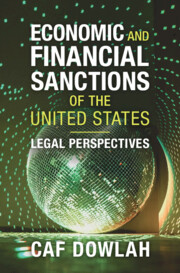Book contents
- Economic and Financial Sanctions of the United States
- Economic and Financial Sanctions of the United States
- Copyright page
- Dedication
- Contents
- Figures
- Tables
- Preface
- Table of Cases
- Table of Statutes and Regulations
- Conventions, Treaties, and Resolutions
- Presidential Executive Orders
- Abbreviations
- 1 Overview of Economic and Financial Sanctions
- 2 Economic and Financial Sanctions under International Law
- 3 Legal Frameworks of US Economic and Financial Sanctions
- 4 Enforcement Infrastructures of US Economic and Financial Sanctions
- 5 US Economic and Financial Sanctions against the Russian Federation
- 6 US Economic and Financial Sanctions against the Islamic Republic of Iran
- 7 US and Multilateral Sanctions Regimes against the Republic of Iraq
- 8 US Economic and Financial Sanctions against the Republic of Cuba
- 9 US Economic and Financial Sanctions against the Bolivarian Republic of Venezuela
- Index
- References
8 - US Economic and Financial Sanctions against the Republic of Cuba
Published online by Cambridge University Press: 22 March 2025
- Economic and Financial Sanctions of the United States
- Economic and Financial Sanctions of the United States
- Copyright page
- Dedication
- Contents
- Figures
- Tables
- Preface
- Table of Cases
- Table of Statutes and Regulations
- Conventions, Treaties, and Resolutions
- Presidential Executive Orders
- Abbreviations
- 1 Overview of Economic and Financial Sanctions
- 2 Economic and Financial Sanctions under International Law
- 3 Legal Frameworks of US Economic and Financial Sanctions
- 4 Enforcement Infrastructures of US Economic and Financial Sanctions
- 5 US Economic and Financial Sanctions against the Russian Federation
- 6 US Economic and Financial Sanctions against the Islamic Republic of Iran
- 7 US and Multilateral Sanctions Regimes against the Republic of Iraq
- 8 US Economic and Financial Sanctions against the Republic of Cuba
- 9 US Economic and Financial Sanctions against the Bolivarian Republic of Venezuela
- Index
- References
Summary
This chapter focuses on the Republic of Cuba, a small South American neighbor of the US, which has endured near-comprehensive sanctions unilaterally imposed by the US for over six decades squarely because of the nation’s unyielding adherence to the communist ideology. The chapter uncovers historical layers of the sanctions regimes, along with their legal underpinnings, navigating through the Kennedy to Trump administrations, and exploring the extraterritorial natures of some of the key legislations, such as the Cuban Democracy Act (1992) and the Helms–Burton Act (1996). The chapter also assesses the impacts of prolonged sanctions regimes on Cuba’s economy and population.
Keywords
- Type
- Chapter
- Information
- Economic and Financial Sanctions of the United StatesLegal Perspectives, pp. 272 - 296Publisher: Cambridge University PressPrint publication year: 2025

